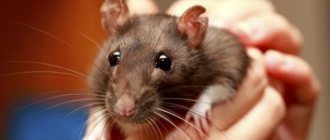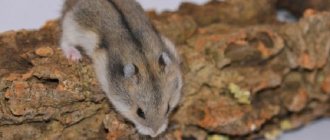Hamsters are fairly quiet animals, but in special situations they can make different sounds. This behavior cannot be ignored, because this is the only means of so-called communication between pet and owner.
Let's find out what some of the hamster's sounds mean, and how the owner should act in an unusual situation.
Variety of sounds
Newborn hamsters are quite sociable. They constantly whistle, coo and even chirp like chicks. An adult hamster makes sounds when it is overwhelmed with emotion or pain.
Observations of small pets have shown that not all breeds tend to make sounds. For example, the Syrian hamster squeaks only in acute pain, and the Djungarian hamster tends to express any feelings with its voice.
Sound options:
It is very difficult to accurately determine the emotions that the Djungarian hamster is trying to express through sound. The owners, in addition to hearing, will have to turn on their powers of observation. For example, a rodent may hide in a house, coo quietly, and thus refuse to go for a walk.
If you try to catch it, it will squeak, dodge and slip through your fingers. In such a situation, it is better to leave the hamster alone.
Important! When a rodent cries and squeaks for no apparent reason, you should immediately contact a veterinarian.
The main causes of strange sounds made by a hamster
There are several reasons why your pet may become unusually noisy.
These include:
- stress;
- hunger and thirst;
- pain;
- discomfort;
- improper living conditions, food;
- difficulty breathing;
- protection of territory;
- greetings;
- mating games;
- fear;
- powerful emotions.
Stress, pain and discomfort can cause noise.
Hamsters have character. They may become upset and start squeaking when their owner disturbs them at the wrong time. If the owner continues to insist on communication, the pet may make angry screams and even bite the person.
Anxiety and stress
A hamster is a small, defenseless animal that is completely dependent on its owner. For this reason, it is not difficult to provoke stress in your pet. For example, cleaning the cage or rearranging accessories can cause discomfort. Even replacing old bedding with a new one can cause distress in the rodent. It is important for him to smell himself, so you should leave some of the old sawdust while cleaning.
If there are no objective reasons for stress, you should let the animal calm down alone, giving it a quiet and calm place. For example, it is wise to rearrange the cage if the owner is planning a noisy celebration. The animal will experience stress from the temporary move, but for the rodent it is much better than being the center of attention.
You should not try to calm your hamster by picking him up. This can drive your pet into a fit of rage.
Thirst and Hunger
A hamster in a cage cannot get food and water on its own. If there is a shortage of food, all he can do is squeak, trying to attract the attention of the owner. If the owner has previously replenished the supplies in the feeder and drinker after the “notification”, the behavior will be fixed. The hamster will do this more often and may squeak when there is still food, but it is no longer enough.
If there is a lack of food, the hamster attracts attention to itself.
If owners always replenish food supplies, then newbies have problems with water. Inexperienced owners sometimes believe that there is no need to give liquid to their pets separately; foods with a high moisture content are sufficient. However, the water obtained along with fruits and vegetables is often used not for the needs of the body, but for the removal of the resulting substances. Lack of freely available fluid leads to dehydration and problems with the kidneys and heart.
Experienced owners recommend placing a special drinking bowl in the cage. The water in it is always fresh; it is enough to change it once every 1–2 days. The hamster cannot accidentally contaminate the liquid with particles of bedding or food. The drinking bowl eliminates situations where the animal turns over the bowls. However, not all pets can drink from the device.
A hamster may squeak from thirst even if there is a drinking bowl in the cage. In this case, he will have to be taught by bringing him to the end of the drinking tube.
Pain and discomfort
Hamsters tend not to show their discomfort. This is a natural instinct: if an animal shows weakness, it will be killed by predators or neighbors. When a pet screams, squeaks or cries because of pain, it means that the discomfort is unbearable and there are serious health problems.
Sometimes the reason can be seen with the naked eye. For example, swelling in the oral cavity indicates clogging and inflammation of the cheek pouches. Dirt in the anal area indicates diarrhea: hamsters are clean and always carefully monitor the condition of their coat. Your pet may squeak due to ingrown claws or wounds on the body. If you cannot find the cause, but the animal often screams, you should contact a veterinarian: not all pathologies have obvious signs.
Itching from parasites
Hamsters are highly susceptible to dermatological pathologies, including infection by mites. The itching in such diseases can be so unbearable that the animal will become nervous and aggressive, begin to scratch itself into wounds, squeak, hide and attack the owner when examined.
Itching from parasites causes the hamster to become nervous.
Characteristic signs of dermatological pathologies include partial or complete baldness. The pet's skin turns red and crusts over. Peeling is often observed. The fur becomes dull and is easily pulled out even with the slightest impact. The animal behaves restlessly, scratches the affected areas, and becomes lethargic. In severe cases, hamsters hide in shelters and try not to go outside.
If alarming symptoms appear, you should contact your veterinarian. He will take pieces of skin, crusts and fur for microscopy. Thanks to the tests, it will be possible to establish the cause of the discomfort. After receiving the results, the specialist will prescribe medications.
Additionally, owners are advised to adjust the housing conditions, replace the bedding, and disinfect the cage with accessories.
Respiratory tract infection
In this case, the animal sniffles and sneezes more often, but sometimes pets can squeak. Respiratory diseases are accompanied by lacrimation, the formation of crusts on the fur, lethargy, weakness, etc. Sometimes breathing problems cause eye pathologies. To clarify the diagnosis, you need to contact a veterinarian. Lack of help is fraught with the rapid death of the pet, since respiratory infections in rodents progress quickly.
A respiratory tract infection can lead to death.
Poor living conditions
A hamster may squeak if it is dissatisfied with its conditions. The animal wants to get out to change its place of residence, but cannot do this because of the cage. For this reason, he can only scream, notifying the owner of the problem. Dissatisfaction can be caused by dirty bedding, high temperature, unsuitable food, the presence of other pets nearby, overcrowding, lack of fresh air, etc. The latter is often observed when keeping rodents in aquariums.
The problem may lie not only in incorrect, but also in stressful conditions. For example, after moving to a new owner, a hamster needs at least 2-3 days to adapt. At this time, it is important to monitor the pet, since squeaking may also indicate pathologies.
Territory defense
Hamsters are territorial animals. Most often, they are not happy with neighbors, so keeping several individuals in one cage is not recommended: this can lead to fights, serious injuries and even death of pets. When defending territory, rodents emit loud squeaks and hisses. Their aggression can be directed not only at members of their own species, but also at other animals or humans. For example, hamsters often hiss when dogs or cats approach their cage. It is recommended to keep the rodent's home in a safe place.
Greetings
Sound signals are not always associated with negative events. With the help of squeaks, animals can “talk” to each other. Most often, this phenomenon indicates mating games. If the hamster squeaks only when it sees its owner and does not show other signs of anxiety, this means that the rodent is happy to see the person.
Sound signals may occur if the hamster is happy to see a person.
How to decipher sound signals
Caring owners will not deliberately tease the animal in order to hear the hamster squeak. The added stress shortens a hamster's already short life. But it's helpful to have an idea of what beeps might mean.
Djungarians make a faint squeak as a greeting. Little hamsters are happy to meet their owner and try to attract his attention. But the reason may be more mundane: the pet has run out of food and is asking for a refill on the feeder.
Interesting! Males use squeaks to attract the attention of females. The hamster squeaks love melodies to his beloved before mating.
Pets sometimes make strange squeaking noises when they sleep. During an exciting dream, the hamster may move its legs. However, constant squeaking at night indicates pain, so you will need to consult a veterinarian.
Snort
Hamsters sometimes begin to snort or snore loudly. The most common cause is nasal congestion. A short sneeze will help clear your pet's airways of dust and crumbs, but a cold will require special treatment.
Sniffling
Heavy breathing signals a problem in your pet's body. Most likely, the animal was in a draft for a long time and caught a cold. If the snoring is accompanied by shortness of breath, the rodent needs to be treated immediately.
Screaming and crying - these sounds are made by hamsters very rarely. Small animals cry in an unusual environment when they are brought to a new home. The only means of calm is loneliness. Owners should only approach the cage to change food and water. After a few days the situation stabilizes.
Hamsters willingly communicate with humans, sit on hands and play. But rodents do not tolerate rough treatment. Constant pestering can turn a good-natured pet into a screaming hamster that can sink its teeth into the hand of the offender.
Important! When rodents cry, tears do not flow. If drops are visible on the face, then the pet has caught a respiratory infection.
The hamster screams from overexcitation of the nervous system. Owners with constant attention can aggravate the situation, and a quiet squeak will turn into a hysterical roar. The only thing that will console the animal is complete loneliness in its own house.
Crackling
Periodically, a chirping sound, like the sound of a woodpecker, is heard from the cage. This means that the animal takes care of its fur. These animals carry out hygienic procedures with the help of their hind legs; sometimes they touch the walls of the cage, and the owners hear a crash.
Hiss
The loudest sound is hissing. This is how the rodent tries to scare the enemy and make him flee. The aggressiveness of the animal's intentions is evidenced by its posture: the mouth is wide open, the front teeth are exposed, the body is arched. If the enemy ignores the warning, a fight may break out.
The hamster screams from strong fright. Usually he tries to escape, but if unsuccessful, he turns over with his paws up and makes a piercing sound.
Causes
- Marriage games.
When a male hamster courts a female, he sings a song to her. The most gallant individuals perform a serenade for the female before starting mating.
- Good mood.
There is no need to worry prematurely. Quiet squeaking can mean joy from a pleasant meal or meeting with the owner. If your hamster is cheerful and energetic, but starts squeaking when he sees you, know that this is how he says hello!
- Stress.
The hamster may become agitated, for example, when moving. New surroundings and smells frighten the fluffy, and he may squeal. It usually takes a rodent about a week to get comfortable in a new space. During these days, it is recommended not to disturb the hamster, not to squeeze it, not to pick it up. Over time, the pet will adapt and stop squeaking.
- Defense of the territory.
The cute hamster becomes aggressive when it comes to protecting his territory from any other rodents, including his own brothers. If the owner carelessly places two hamsters in the same cage, a fight will inevitably occur. Before a fight, the hamster makes loud sounds similar to squeaking and hissing, as well as crackling and chirping to scare the enemy.
- Need for help.
If your hamster squeaks when it hasn't done so before, check to see if it has food and water. Perhaps he is tormented by hunger or thirst. An animal may also vocalize if it is hot or its cage is dirty.
Oddly enough, some are sure that hamsters do not drink water, but get all the necessary moisture from juicy food. In fact, hamsters, excluding newborns, need water. You need to place a drinking bowl in the cage where there will always be fresh water. It is necessary to train your pet to use it.
- Dreams.
When a hamster squeaks and twitches in his sleep, he is simply dreaming. He can twitch his limbs, make faces and make sounds.
- Bad feeling.
Illness is a serious reason why a small rodent may squeak. Behavior can tell about it: lethargy, loss of appetite, decreased activity, drowsiness. Appearance also says a lot about the health of the animal. He stops cleaning the fur, which makes it look sloppy.
The first thing you need to do is examine your pet: examine its paws, teeth, and skin. Both squeaking and loud screams can indicate discomfort. For example, a squeak after a fall indicates injury. After all, hamsters do not know how to fall and jump correctly, like cats. Therefore, falling from a height, they often receive serious damage.
After being bitten by a subcutaneous tick, the hamster experiences such acute itching that it screams, squeals, gets angry and nervous. If it is not clear why your pet is squeaking, and there are skin problems, demodicosis should be suspected.
Hamsters may experience discomfort due to poor diet. Sometimes they squeak for this reason. In this case, it is worth reviewing your pet’s diet.
How to train a hamster to come when you call
Co-author(s): Pippa Elliott, MRCVS. Dr. Elliott, BVMS, MRCVS is a veterinarian with over 30 years of experience in veterinary surgery and the care of companion animals. She graduated from the University of Glasgow in 1987 with a degree in Veterinary Medicine and Surgery. He has been working at the same animal clinic in his hometown for over 20 years.
This article has had 18,863 views.
Hamsters can be trained to come when called, just like dogs and cats. The key point in this matter is to find a favorite treat that will motivate the animal; thanks to the treat, the process of so-called “training” will be consistent and regular. If you want your furry pet to come to you as soon as you call his name, stock up on healthy treats that your hamster will love, and also be prepared to set aside a few free minutes every day for training. In addition, you can use a special clicker for more effective training - this will help the hamster learn its name faster.
Advice:
If you are still thinking of a suitable name for your new pet, try to choose something shorter and simpler, because this will make it much easier for your hamster to remember his name. For example, a simple nickname like "Ruby" is easier to remember than "Prince Charles."
Did you know?
In fact, hamsters do not understand and do not remember their names, as people do, they only recognize a familiar set of sounds. If you regularly say the same word (animal's name), over time the hamster will associate a set of these sounds with something good and pleasant (for example, receiving a treat).
Source
Classification of sounds
The busy rustling of paws can often be heard from the hamster cage, but not all owners hear the voice of the pet. The Syrian hamster is a calmer and more silent breed; it begins to bawler only in cases of extreme dissatisfaction or illness. But Djungarians more often express their feelings with their voices. It happens that a hamster makes strange sounds, and the owner cannot correctly identify them. Accordingly, it is impossible to establish the reason for this pet’s behavior.
Here are the sounds a hamster makes:
- Squeak. The sound is high-pitched, but the animal’s mouth does not open.
- Hissing or wheezing. Nasal dull sound.
- Cry. He sounds pitiful, his mouth slightly open. At the same time, the animal is inactive.
- Snorting. Sounds like a muffled sneeze.
- Scream. A repeated sound comes out of a wide open mouth. At the same time, Khoma makes sudden aggressive movements or tries to hide.
Having determined the type of sound, you need to understand why the Djungarian hamster makes it. In general, the reasons are the same for all small rodents, it’s just that the jungarians are the most “talkative”.
Why do hamsters squeak?
The most common sound is the squeak of a hamster, which can vary in volume, from a barely audible squeak to a clearly audible whistle. What causes this behavior?
- the animal is happy to see its owner and greets him. If your pet is cheerful and cheerful, but every time you appear it begins to squeak quietly, rejoice: the fluffy one says hello to you!
- the pet wants to talk about his problem. If the hamster squeaks, but he has not done this before, check the contents of the feeder and drinker, in case he has nothing to eat or drink. Also, by squeaking, a homa may hint that the cage needs to be cleaned;
- cares for the female and sings a song to her. There are very gallant hamsters who perform serenades for their chosen one, squeaking before starting mating.
Decoding other sounds
Sometimes rodents snort, like many other animals. If a hamster makes a short, repeated snort, it is simply trying to clear dust or small pieces of food from its nose. Usually homea manages to clean the spout quite quickly.
But if you hear hissing or snorting, then this is a reason to sound the alarm. The little creature could get sick from dampness in the cage or draft. What to do if your hamster is constantly sniffling and choking? The answer is obvious: contact your veterinarian immediately.
Sometimes you may hear your hamster crying. Then think about your behavior: maybe you disturbed the animal at the wrong time, or offended it in some way? By the way, if you continue to pester your hamster, peaceful crying may turn into an angry scream. Small hamsters often cry; they are afraid because they are not yet accustomed to their new home and owner. But if no one has offended the animal, and the pet makes plaintive, drawn-out sounds, then something clearly hurts. Be sure to visit your veterinarian soon.
For one reason or another, the homa may become angry. Then you will hear the hamsters scream, and you will regret that you angered a harmless creature. An animal in a state of aggression is capable of not only screaming heart-rendingly, but also rushing at people. But rage and anger are not the only reason for this behavior. A hamster can also scream from very severe pain.
Attention! Do not pull your pet by the ears or pick it by the scruff of the neck. This kind of disrespectful behavior can make your pet angry!
Symptoms of stress in hamsters.
All animals are unique and therefore experience and express stress differently. For this reason, it is important to be aware of any changes in your hamster's behavior; recognizing such problems can help you identify illnesses or symptoms of stress in your hamster early on...
To find out if your hamster is showing symptoms of stress , check out the recognizable signs below:
- Hyperactivity Stressed hamsters tend to be incredibly hyperactive, even in cages. They will be constantly moving, running fast on their wheels, trying to climb onto their cages, and appearing more nervous and alert than usual. These are all clear signs that your hamster has built up stress and tension and is trying to find a way to release it. If your hamster is not surrounded by an enriched environment, he will show signs of destructiveness, aggression and nervousness.
- Unusual Habits Every hamster needs to live in an enriched environment to use its physical, cognitive, emotional and social skills. If a rodent is subjected to a sedentary routine in an environment that is not stimulating, it will try to expel energy and relieve stress in other ways. You have forms they can arise due to unusual behavior or dangerous habits. One of these common unusual habits includes biting its cage.
- Compulsive Behavior Stress in most animals, including hamsters, can occur due to compulsive and repetitive behavior. Examples of this include; constantly scratches, constantly gnaws, turns around its axis several times, constantly cleans its body, etc...
- Aggression : Stress is one of the main causes of aggression in hamsters. In addition, stressed hamsters tend to be more reactive than usual. If your rodent shows his teeth, he moves his ears back or grunts: he is preparing to attack. In these situations, you should avoid your hamster and give him some time to calm down and feel safe. If you notice that your hamster is constantly trying to bite you, is showing its teeth, or has become more aggressive in general: we recommend consulting with your veterinarian.
- Hair Loss: Hamsters suffering from chronic stress often experience changes in their fur. A stressed hamster may begin to lose hair or have noticeably greasy hair. Some rodents even tear their hair through insensitive scratches, causing baldness.
- Hamster noise released Hamsters are usually quiet and/or very quiet animals. However, when they are stressed, these small animals make characteristic noises. Hamsters snort when they are afraid, and when they are threatened they let out a grunt. When they get very nervous, they may make squeals or squeals, which are usually very rare for these rodents.
- Excessive salivation : Stress, fear, anxiety and nervousness interfere with saliva production. A stressed hamster may suffer from excessive salivation as a physical reaction to tension.
- Persistent attempts to escape : A stressed hamster will try to escape a negative environment. When your hamster is alert or preparing to run away, he will appear with his ears forward and cheeks puffed out.
- Muscle Stiffness and Tremors When a hamster is under extreme stress or fear, its muscles become more tense. In extreme cases, this muscle stiffness is so intense that the rodent's body will tremble.
- Behavioral changes : Stress in hamsters can cause changes in their usual behavior. A stressed rodent may become more aggressive, shy, anxious, sad, or afraid of the usual. This is why we emphasize getting to know your hamster's personality in order to be able to detect any change.
What to do if Homa makes sounds?
If your Syrian or Djungarian hamster squeaks or makes other sounds, do not ignore it! First, figure out why your hamster is screaming, and then try to eliminate the cause.
- A newly acquired rodent should be left alone for a while so that it can settle into its new home. You will see: in a few days the pet will stop crying and begin to arrange its life.
- Check if everything necessary for a hamster's happiness is present in the cage.
- If the fluffy screams with anger, tries to rush and bite, there is no need to approach the animal, you will irritate him even more! Leave the homa alone for a while, let him come to his senses and restore his peace of mind.
- But plaintive crying or cries of pain should not be ignored. Find a good Aibolit who will save your funny friend from all ailments.
Respect for the animal, proper care and care are the key to a good mood for your pet. When the fluffy is healthy and happy with everything, you will only hear a joyful squeak of welcome from him.
Remember: a hamster's emotions and the reasons that cause them are very similar to human ones. Think about what kind of treatment you yourself would like and do everything to ensure that your baby has a good life. Don’t bother with it at inopportune times, but don’t forget to visit the animal so that it doesn’t get bored.
Source
Learning how to care for a hamster
When getting a pet, you need to find out as much as possible about its habits and the peculiarities of caring for it. Here are some tips:
- In new conditions, the animal may initially experience stress, so it should not be disturbed.
- When changing bedding, leave a piece for the animal to recognize its smell.
- Periodically do a general cleaning of the cage.
- Do not put several individuals in one cage. Each of them should have their own territory.
- Study the dietary features of hamsters of this breed.
If a Djungarian hamster squeaks and at the same time gnaws the bars of the cage, it means that the owner is not caring for him correctly.
Hamster sounds - what to do?
Hamsters hiss when they try to defend themselves and sense danger. Just don't offend the little rodent and he will calm down.
Sometimes owners of Djungarian hamsters feel like they are cracking. That is, it makes sounds similar to the cracking of a woodpecker or something similar. The reason here is simple. Hamsters groom their fur frequently. Sometimes, sitting somewhere in a house, they begin to scratch with their hind legs with very fast, frequent movements. If a paw touches the wall of a house, for example, the result is a frequent knocking sound similar to the cracking of a woodpecker.
If the hamster is crying, then something may be hurting him. A screaming hamster can signal that all is not well. If your pet is crying or yelling, try to watch him carefully. It might make sense to go to the vet.
But the most common sound hamsters make is squeaking.
How to calm a nervous hamster
There are some guidelines that can continue to prevent stress or calm a nervous hamster . The moment you notice that your hamster may be feeling stressed, leave him and give him a chance to calm down. After this, consult your veterinarian to rule out any pathology and make sure your hamster is healthy...
Additionally, it is important to always provide your hamster with basic care and preventive medications to maintain a balanced temperament. Follow these tips on how to keep your hamster healthy:
- Enrich your environment : Enriching your environment is key when preparing your hamster's cage. An enriched cage will allow the rodent to exercise and have fun in his absence. Plus, it will help you manage a healthy weight. Although a traditional wheel is useful for stimulating your hamster, we recommend providing other toys and accessories to stimulate your cognitive abilities...
- Socialization: Despite requiring relatively simple care, hamsters require the attention and care of their owners to remain active, happy and healthy. Therefore, in addition to enriching your hamster's cage, you should interact with other animals in your environment.
- Provide adequate preventive medicine. Some diseases can cause changes in a hamster's behavior. Therefore, it is very important to offer your hamster adequate preventive medications so that you have a strong immune system. Remember: visit your veterinarian every 6 months, provide your furry friend with a balanced diet, disinfect your cage periodically, and keep her physically and mentally active.
This article is purely informational. HowMeow.ru does not have the right to prescribe veterinary treatment or diagnose. We invite you to take your pet to the vet if you are suffering from any illness or pain.
Why do hamsters squeak?
What causes a hamster to squeak? First of all, understand that hamsters, although quiet by nature, are living beings, and with their squeaks they signal something that is extremely disturbing and bothering them.
- Check containment conditions
- Review your diet; it may require more balance.
- Is your hamster getting enough water?
- Is the hamster getting enough food?
- Fear. Excitement.
Of course, rodents, which includes your pet, receive virtually no water in the wild. But do not forget that domesticated hamsters were tamed by people many generations ago, and are accustomed to receiving food and drink in sufficient quantities. The hardships of living in natural conditions already create discomfort , which they can signal to us with their squeaks. Therefore, first of all, pay attention to whether your pet is getting enough water and food.
Health problems
In many ways, the health of your pet depends on the food it receives. Domesticated rodents, although omnivorous, need sufficiently balanced food . A lack of vitamins and microelements alone may well lead to internal problems, which your pet signals to you. What to do in this case?
Make his diet more varied.
The range of sounds that rodents make
Normally, hamsters make noise relatively rarely. The only exceptions are the sounds of grinding teeth and rustling bedding. If your pet makes noise frequently, this may indicate health problems or poor health.
When decoding sounds, you need to take into account their nature. For example, hamsters sometimes emit a simple squeak during mating games. Crying in most cases indicates illness or stress.
Squeak
It represents a high pitched sound. When playing it, the rodent's mouth does not open. An animal can squeak either when it is dissatisfied or, for example, when it wants to greet its owner.
Snort
It sounds like a muffled sneeze. Hamsters make such sounds when any particle gets into their nasal cavity: bedding, dust, food, etc. Most often, the pet quickly manages to get rid of the irritant. If an animal often snorts or grunts, you need to pay attention to its health. This behavior may indicate the presence of allergies, colds, rhinitis, pneumonia, etc.
Sniffling
This is a dull nasal sound. Normally, a pet should not make it. Most often, wheezing indicates problems with the respiratory system. Rodents are susceptible to colds, complications arise quickly, so it is recommended to consult a veterinarian.
Sniffling occurs when you have trouble breathing.
Cry
An uncharacteristic sound for hamsters. Sometimes rodents remain silent even if they are severely injured. Crying indicates extreme stress. It can be associated with both harmless and dangerous reasons. For example, a hamster sometimes cries for several days after moving. In this case, there is no reason to worry. It is enough to place the cage in a quiet and dark place so that the pet gets used to it.
If the conditions under which the hamster is kept have not changed and he has everything, you need to pay attention to the health of the rodent. Animals often cry when they have colic. The latter are often provoked by fermentation. In this condition, it is necessary to adjust the rodent's menu. Severe fermentation can lead to the death of your pet. However, colic is not the only problem that can cause crying. The animal may suffer from scabies, demodicosis, plague, etc.
Hamsters, unlike people, cry without tears. Discharge indicates pathologies of the organs of vision or breathing, allergies, etc.
If they appear, you need to contact a veterinarian.
Crackling
It is considered one of the sounds that does not cause concern. It is not the hamster itself that makes noise, but the objects around it when it comes into contact with it. For example, this happens when an animal climbs into a house and begins to intensively clean its coat of debris. While washing, the pet touches the walls of the house with its paws.
The cracking sound occurs due to contact with surrounding objects.
Hiss
It may be due to several reasons. First of all, this sound is a normal reaction of a hamster to a threat. The animal emits it after moving or at the sight of another pet, a stranger, etc. If the rodent begins to hiss, the owner needs to analyze the situation and try to reduce the level of stress for the hamster. If there are no apparent reasons for nervousness, it is worth considering the version with respiratory diseases: the pet may hiss due to difficulty breathing.











